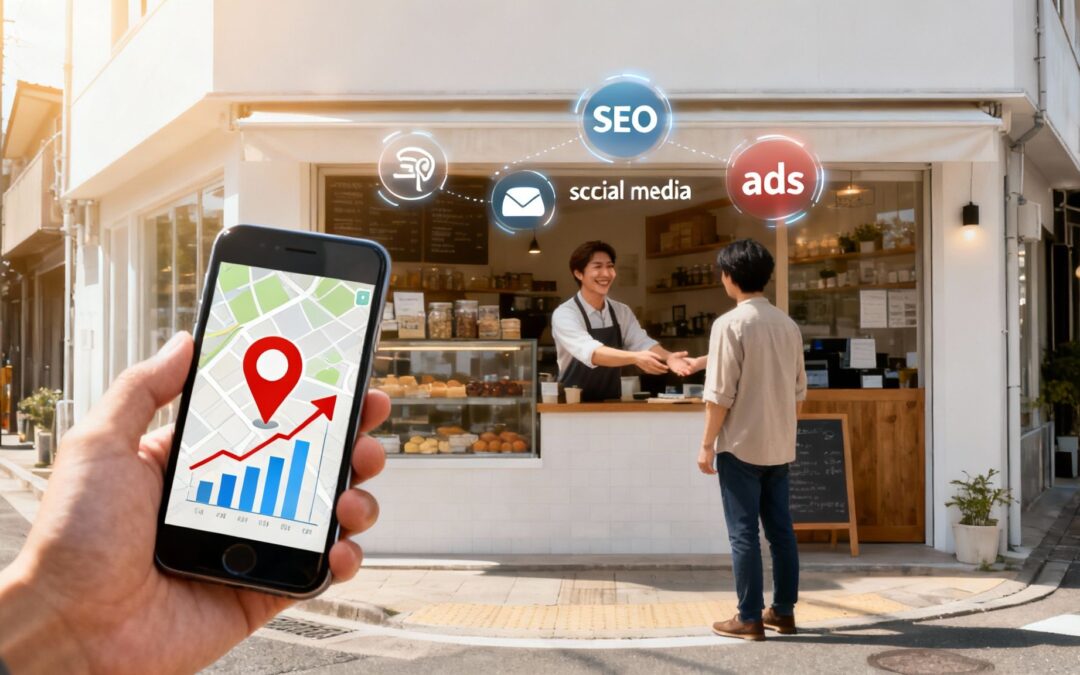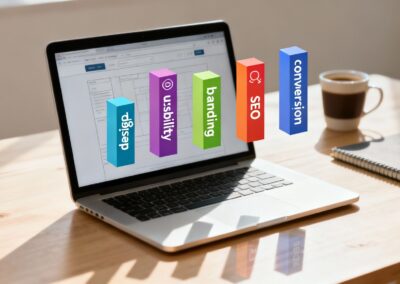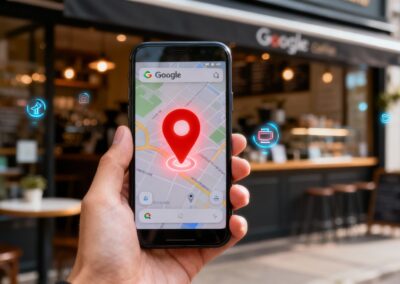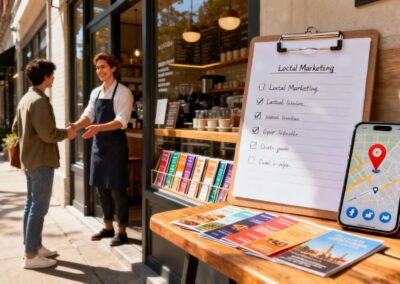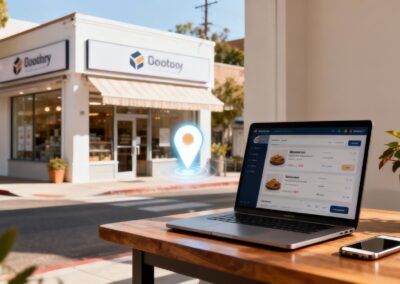Let's be honest, the way customers find a local shop has completely changed. Foot traffic is still important, but digital traffic—driven by those "near me" searches on a smartphone—is now king. This shift means even a small bakery can go toe-to-toe with a national chain by mastering digital marketing for local businesses.
Why Digital Marketing Is Your New Main Street
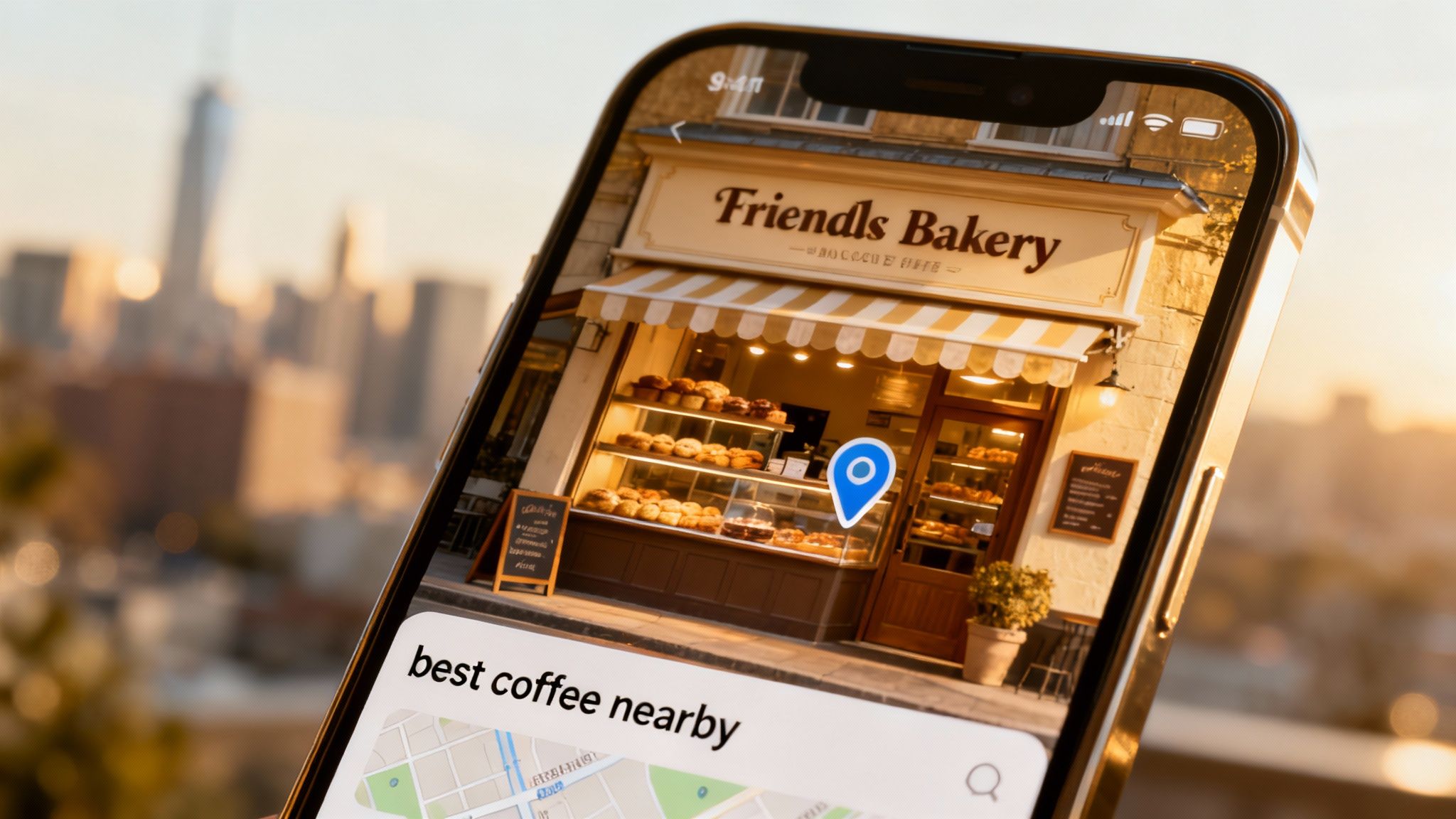
Think about the last time you needed something specific, like the "best coffee nearby" or an "emergency plumber." You probably didn't just wander down the street hoping for the best. You pulled out your phone and searched. That immediate, intent-driven search is exactly where modern commerce begins for local businesses.
This guide cuts through the noise. We're not going to talk about complex theories or expensive enterprise-level campaigns. Instead, we'll focus on the essential, actionable steps that actually get more local customers through your physical or digital door.
The Power of Local Intent
The numbers don't lie. A staggering 99% of consumers have used the internet to find information about local businesses in the past year. Digital search has simply become the main discovery tool.
What's even more telling is that a striking 4 out of 5 online searches have local intent. You can dig into some more local SEO insights about these powerful statistics to see the full picture.
This means people aren't just browsing aimlessly. They're actively looking for services and products right in their own backyard. Your only goal is to be the solution they find.
The core of digital marketing for a local business isn’t about being everywhere online. It's about being in the right place at the right time, specifically when a potential customer in your neighborhood is actively looking for what you offer.
To help you get there, here's a quick overview of the key channels we'll be covering.
Core Digital Marketing Channels for Local Businesses
| Channel | Primary Purpose | Key Success Metric |
|---|---|---|
| Local SEO & GBP | Appearing in "near me" searches and on Google Maps | Map Pack Rankings & Clicks |
| Targeted Social Media | Building community and engaging with local customers | Post Engagement & Reach |
| Local Service Ads | Capturing high-intent leads for service-based businesses | Qualified Leads (Calls/Messages) |
| Email & SMS Marketing | Nurturing repeat business from existing customers | Customer Return Rate |
By mastering these core areas, you're not just creating an online presence; you're building a powerful, predictable system for attracting local customers.
Turn Your Google Profile Into Your Best Salesperson
Think of your Google Business Profile (GBP) as your virtual storefront. For many potential customers, this profile is the very first time they'll encounter your business. Simply listing your address and hours isn't enough anymore if you want to stand out.
A well-maintained profile is one of the most powerful tools in your local marketing kit. It becomes an active, persuasive salesperson working for you around the clock, converting searchers into customers.
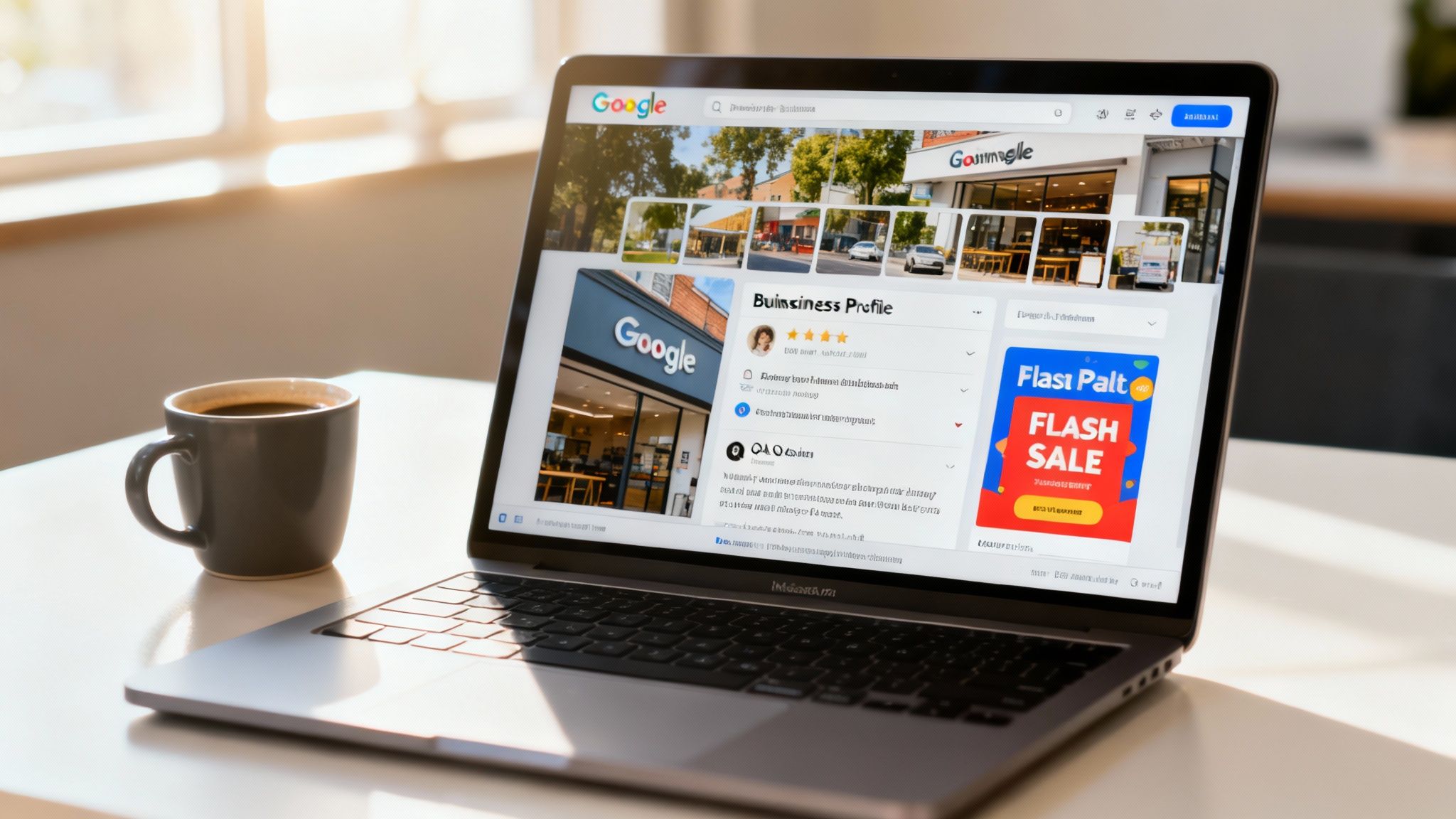
Look at how much a complete profile can tell someone at a glance. By actively managing these details, you're building trust and showing value before a customer even thinks about clicking to your website.
Beyond the Basics: Activating Your Profile Features
Many business owners set up their GBP and then forget about it. That's a huge missed opportunity. The real magic happens when you start using its dynamic features to actively engage people. This means consistently adding fresh content that highlights what makes you great.
A great place to start is the Q&A section. Don't wait for customers to ask questions. Get ahead of them. Post your own frequently asked questions and answer them thoroughly. Think about what people always ask, like "Do you offer free estimates?" or "Is there parking nearby?" Answering these upfront saves everyone time and shows you're on top of things.
Another fantastic tool is Google Posts. Use them to announce a flash sale, promote a community event, or share a recent customer success story. These updates show up right in your profile and can create timely excitement. I worked with a local plumber who started posting high-quality photos of finished bathroom renovations to their GBP. The result? A 50% jump in calls for similar projects. That’s the power of showing, not just telling.
Building Trust Through Social Proof
Reviews are the lifeblood of any local business today. They’re the new word-of-mouth, and they're one of the first things potential customers look for. Your goal should be to encourage a steady stream of authentic reviews and respond to every single one.
- Responding to positive reviews shows you appreciate your customers.
- Addressing negative reviews professionally shows you take feedback seriously and are committed to making things right.
This consistent engagement is what builds a rock-solid, trustworthy reputation online. To get your profile working for you, it's essential to learn how to optimize your Google Business Profile for top rankings.
A verified and complete profile sends a massive trust signal. In fact, customers are 2.7 times more likely to trust businesses that provide a thorough and accurate profile on Google.
The numbers don't lie. Complete profiles get, on average, over 21,600 views annually in Google searches. And get this: 78% of local searches on a smartphone end in a purchase.
Dominate Local Search with Simple SEO Wins
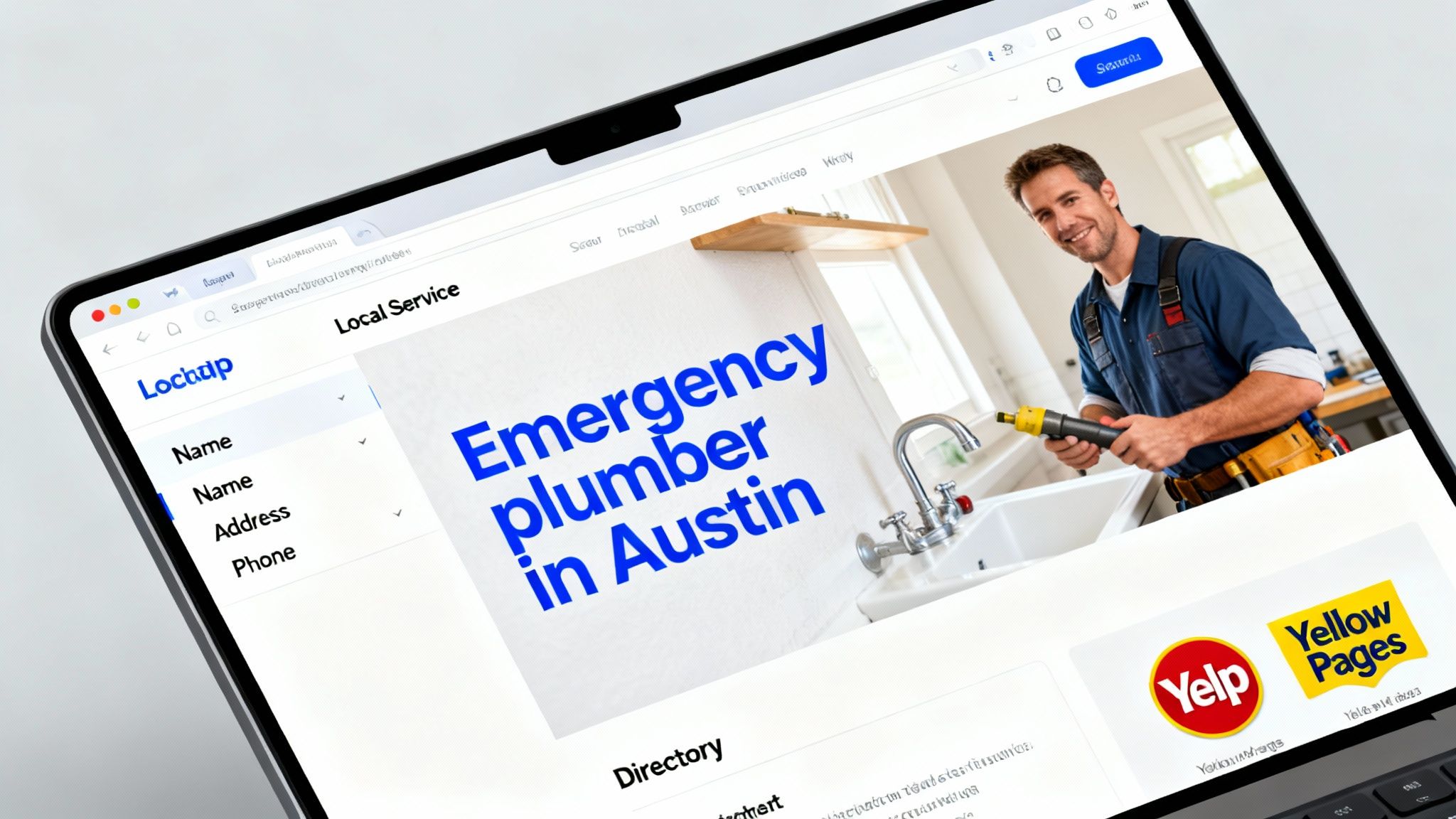
Search Engine Optimization (SEO) probably sounds more complicated than it is. When you're a local business, it all comes down to a handful of simple, powerful actions. Forget the technical jargon. Your goal with local SEO is just to make it incredibly easy for people in your immediate area to find you right when they need your service.
It’s all about showing up when someone in your town searches for "emergency plumber in Austin," not just "plumber." That geographic detail makes all the difference, separating a potential customer a block away from someone a hundred miles away. This focused approach is what makes digital marketing work for a local business.
Speak Your Customer’s Language
First, you have to get inside your customer's head. What exact words are they typing into that search bar? A good starting point is to brainstorm specific service-plus-location keywords.
Think beyond general terms:
- Instead of "bakery," try "gluten-free birthday cakes in San Diego."
- Instead of "landscaper," think "weekly lawn care in Portland."
- Instead of "mechanic," get specific with "Honda oil change near downtown Denver."
Weave these specific phrases naturally into your website content, especially on your homepage and service pages. This is how you signal to search engines exactly what you offer and where you offer it, which increases the chances they'll show you to the right people.
Key Takeaway: Getting found online isn't about being clever; it's about being crystal clear. Use the exact phrases your neighbors are searching for, and you'll connect with them.
It's also worth noting that "near me" searches have exploded, growing by as much as 500% in recent years. This tells us that people are on their phones, looking for immediate, local solutions. Even better, 88% of people who search for a local business on mobile end up visiting a store within a day.
Keep Your Business Info Consistent
One of the most critical and surprisingly common mistakes in local SEO is inconsistent business information. I'm talking about your Name, Address, and Phone number, what marketers often call your "NAP."
When your details are all over the place, it confuses search engines and erodes their trust in your business. If you're "Main St." on your website, "Main Street" on Yelp, and "Main St" on another directory, Google might see those as three different entities.
A quick fix is to:
- Audit Your Listings: Just Google your business name and see what pops up.
- Correct Inaccuracies: Jot down every profile that has an old address, the wrong phone number, or a slightly different name.
- Standardize Everything: Decide on one official format for your NAP and make sure it’s identical everywhere.
Become the Local Expert
Finally, creating simple, genuinely helpful content is a fantastic way to position yourself as the go-to authority in your town. Think about the common questions your customers ask you every day. Those are goldmines for content ideas.
For example, a lawn care company in Houston could write a short blog post called, "What's the Best Grass for Hot Houston Summers?"
This strategy does two things brilliantly. It attracts highly motivated customers who are already looking for solutions you provide, and it builds serious trust and authority. To dive deeper, check out this guide on how to improve local SEO with more practical tips.
Connect With Your Community on Social Media
When you're running a local business, social media isn't about chasing viral fame or racking up millions of followers. It's about building real relationships with the people who live and work just a few blocks away. The goal isn't to be everywhere; it's to be on the one or two platforms where your customers actually hang out.
Forget trying to master them all. If you're a cafe known for your incredible latte art, Instagram is your best friend. If you’re a local contractor, you'll likely find that building trust in a neighborhood Facebook group is far more powerful. It’s all about meeting your community where they are and becoming a familiar, trusted name.
Go Beyond Selling Your Services
Your social media feed can't just be an endless stream of sales flyers. People tune that out instantly. Instead, think of your content as a way to build community and provide genuine value. Your social presence should feel like the digital version of sponsoring the local little league team. It shows you care.
I've seen these types of posts get real traction for local businesses:
- Feature a "Customer of the Week": Ask a loyal customer if you can share their photo and a quick story. It makes your regulars feel like stars and shows potential customers you’ve built a strong, happy community.
- Share a Behind-the-Scenes Look: Give people a peek at how your signature bread is baked or introduce the team. That kind of transparency builds a powerful human connection.
- Partner for a Joint Giveaway: Team up with another local business, maybe the boutique next door or the coffee shop down the street. A collaborative giveaway introduces both of you to a new, relevant audience and builds a great sense of local camaraderie.
This infographic breaks down how different community-focused posts can actually move the needle for your business.
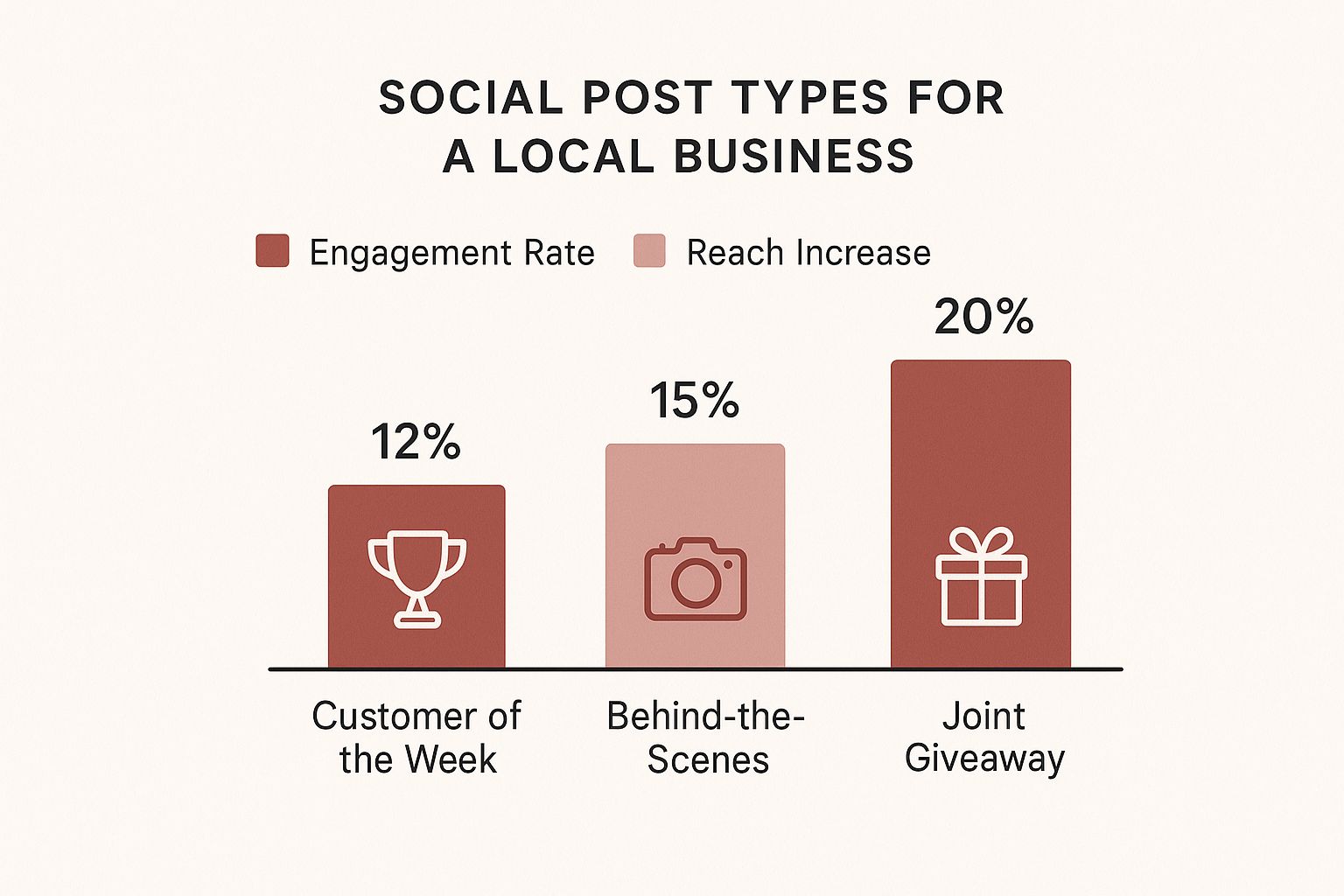
As you can see, teaming up with another local spot on a giveaway can be a fantastic way to drive real foot traffic, while behind-the-scenes content is a proven winner for expanding your reach to new folks.
Use Local-First Platform Tools
Social media platforms have tools built right in that are designed to help with local discovery. Using them is one of the easiest wins for getting in front of people in your service area.
On Instagram, always add a location tag to your posts and stories. It’s a simple tap, but it means your content will show up when someone searches for that location. Likewise, Facebook Events are a great tool for promoting an in-store sale, a workshop, or a holiday special. You can invite your followers directly and even run small, targeted ads to reach others nearby.
The best social media for a local business feels less like marketing and more like being a good neighbor. Just be helpful, be authentic, and be present where your community gathers online.
For a deeper dive into building out your strategy, this guide on social media marketing for small business is packed with useful tips. These simple, consistent efforts are what turn casual online followers into loyal customers who walk right through your door.
Run Smart Local Ads on a Small Budget
Worried about blowing your marketing budget on ads that don't seem to do anything? I get it. The good news is, you don't need deep pockets to make an impact. The secret to smart local advertising isn't about outspending everyone; it's about out-targeting them.
Forget trying to reach the entire city. Your goal is to get your message in front of the people who are most likely to actually walk through your door. This is where hyper-targeting on platforms like Google Ads and Facebook Ads becomes your best friend. You can zero in on customers right down to their zip code or even a one-mile radius around your storefront.
This level of precision is how you make a small budget work like a big one.
A Real-World Example
I once helped a local gym that was finding it tough to bring in new members. We set up a simple Facebook ad campaign with a daily budget of just $10.
Instead of casting a wide net, we targeted only people living within a 5-mile radius of the gym. The ad copy was direct and spoke to a common pain point: "Tired of the commute to your gym? Get a full workout just minutes from home." This ad clicked through to a simple landing page offering a free one-week trial.
The result? They saw a steady, predictable stream of new sign-ups, all from an ad spend that cost less than a few fancy coffees a day. It’s proof that you don't need a massive budget when your message is highly relevant to a specific local audience.
Local Ad Platform Comparison
Choosing where to spend your ad dollars can be tricky. Here’s a quick breakdown of the two biggest players for local businesses.
| Feature | Google Ads | Facebook/Instagram Ads |
|---|---|---|
| Primary Goal | Captures active search intent from people looking for what you offer right now. | Builds brand awareness and targets users based on interests, demographics, and behavior. |
| Targeting | Based on keywords ("plumber near me") and location. Highly effective for immediate needs. | Based on user data like age, location, hobbies, and online behavior. Great for visual products/services. |
| Cost | Typically higher cost-per-click (CPC) but can have a higher conversion rate for urgent needs. | Generally lower cost-per-impression and CPC, making it great for top-of-funnel marketing. |
| Best For | Service-based businesses (plumbers, dentists, lawyers) and businesses solving an immediate problem. | Restaurants, retail shops, gyms, salons, and businesses that benefit from visual appeal. |
Ultimately, many businesses find success using a mix of both platforms. Google Ads can capture the "I need it now" crowd, while Facebook and Instagram ads keep your business top-of-mind for future needs.
Precision Over Power
Your ad strategy should be built on local relevance. Think about it: a staggering 76% of smartphone users who search for something nearby visit a business within 24 hours. These aren't just casual browsers; they are customers ready to act. You can read more about how digital marketing statistics show consumer behavior and see for yourself.
Running local ads is like fishing with a spear instead of a giant net. You're not trying to catch every fish in the ocean, just the ones swimming right in front of you. That precision is what makes a small budget so effective.
This means your ads are tapping into an immediate, tangible need. With more than half of all marketers dedicating at least half their budget to lead generation, the goal is clear: turn online attention into real-world customers. For your business, that means crafting ads that don't just get seen, they get people to take action.
Putting It All Together: Your Local Marketing Action Plan
Getting started can feel overwhelming. But here's the secret: you don't have to do everything all at once. The real magic in local marketing comes from small, focused actions, done consistently.
Think of it this way. You're building a foundation. We'll start with the quick wins that deliver the biggest bang for your buck and then layer on the bigger projects from there.
Your Weekly Focus
These are the high-impact tasks you should knock out every week. We're talking about an hour or two, max, to keep your online presence humming and your customers engaged.
- Google Business Profile "Housekeeping": Set aside 30 minutes. Your only job? Respond to every single new review, yes, even the bad ones. Then, upload a new photo or two. It could be a shot of your team, a finished project, or a happy customer. It keeps your profile fresh and shows Google you're active.
- A Little Social Media Love: Don't overthink this. Just schedule two or three simple posts for the week. Skip the hard sell. Instead, share a helpful tip, ask your followers a question, or highlight another local business you love. The goal is to start a conversation.
Your Monthly Goals
These are your bigger-picture projects. Pick one—just one—to tackle each month. This is how you'll steadily build your authority and expand your reach without getting overwhelmed.
Honestly, the secret to winning at local marketing isn't about having a huge budget. It's about consistency. A handful of small, smart actions repeated over time will always beat a splashy, one-time campaign.
Here’s what a simple, effective monthly rhythm could look like:
- Create One Piece of Helpful Content: Write one solid blog post that answers a real question your local customers are asking. Think "Best Dog-Friendly Patios in [Your Town]" if you run a pet store, not "The History of Dog Food."
- Run a Small, Targeted Ad: Set up a small-budget ad campaign on Facebook or Google. Don't try to reach the whole state. Target a specific zip code, neighborhood, or demographic that matters most to your business.
This approach makes progress feel real. It puts you in the driver's seat and lets you build a powerful local presence, starting right now.
Even with the best plans, you're going to have questions. Here are a few of the most common ones I hear from local business owners just getting their feet wet with digital marketing.
What’s a Realistic Digital Marketing Budget for a Small Business?
There’s no one-size-fits-all answer here, but a good rule of thumb is to set aside 5-10% of your total revenue. The great thing is, when you're starting out, you can get a lot of mileage out of free tools. Your Google Business Profile and organic social media posts cost nothing but your time.
Once you’re ready to put money behind your efforts, you don't need a massive budget. We’ve seen businesses make a real impact with as little as $100-$300 a month on hyper-targeted local ads on platforms like Facebook or Google. The trick is to start small, watch your numbers, and then double down on what’s actually bringing people through your door.
Don't get caught up in spending a lot; focus on spending smart. A small, strategically placed ad that only shows to people in your zip code is infinitely more valuable than a huge campaign with no focus.
Which Social Media Platform Should I Actually Be Using?
Stop trying to be everywhere at once. It's a recipe for burnout. The best platform is simply the one where your customers are already hanging out.
- Own a restaurant, boutique, or salon? Anything highly visual thrives on Instagram. It’s built for showing, not just telling.
- Run a service-based business like a contractor or a financial planner?Facebook is fantastic for building a community, sharing testimonials, and earning trust.
- Mainly serve other businesses (B2B)? Don’t waste your time anywhere else. LinkedIn is where you’ll connect with other professionals and prove you know your stuff.
Pick one platform where you know your ideal customer spends their time and get really, really good at it.
How Long Until Local SEO Actually Starts Working?
I’ll be straight with you: local SEO is a long game. It's more of a marathon than a sprint. While optimizing your Google Business Profile can sometimes give you a quick boost in a matter of weeks, climbing the ranks for competitive local search terms requires patience.
You should plan on 3 to 6 months of consistent work to see significant movement. That means methodically building out your online directory listings, actively encouraging new reviews, and adding helpful content to your website. It's an investment, but the payoff of being the top local result is absolutely worth the wait.
Ready to stop guessing and start seeing real growth in your local market? The team at Digital Lotus Marketing lives and breathes this stuff. We build custom strategies that drive results for businesses just like yours. Let's build a plan that works for you.

